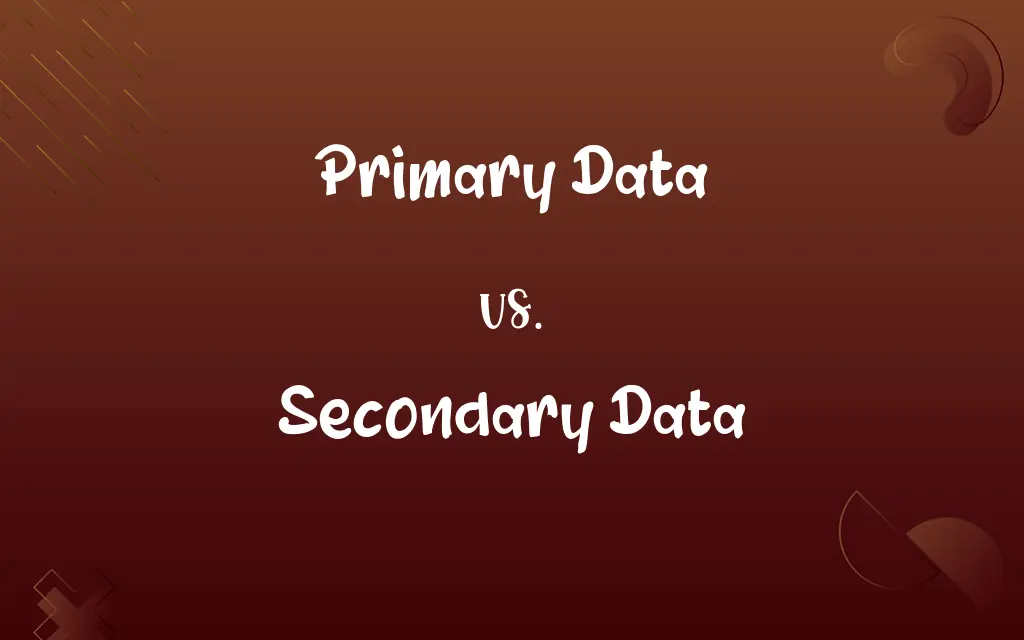Primary Data vs. Secondary Data: Know the Difference

By Shumaila Saeed || Published on January 23, 2024
Primary Data is data collected firsthand for a specific research purpose. Secondary Data is data previously collected for another purpose but used for a different study.

Key Differences
Primary Data is gathered directly from the source, tailored to the researcher's specific needs. Secondary Data, conversely, is collected by someone else, originally for a different purpose, and later used in research.
Shumaila Saeed
Jan 23, 2024
Primary Data is often more accurate and reliable for the specific research question since it is collected firsthand. Secondary Data might not be as precisely relevant to the researcher’s specific question, given it was collected for other reasons.
Shumaila Saeed
Jan 23, 2024
The collection of Primary Data can be time-consuming and expensive, as it involves designing research methods and gathering new information. Secondary Data is generally more cost-effective and quicker to access since it already exists.
Shumaila Saeed
Jan 23, 2024
Primary Data allows researchers to control the quality and nature of the data collected. In contrast, the quality and relevance of Secondary Data can vary and is not under the control of the researcher using it.
Shumaila Saeed
Jan 23, 2024
Primary Data can provide up-to-date and highly relevant insights for a specific study. Secondary Data, while potentially providing a broader context, may be outdated or not entirely applicable to the current research.
Shumaila Saeed
Jan 23, 2024
ADVERTISEMENT
Comparison Chart
Source of Data
Directly from the original source
Collected by someone else for different purposes
Shumaila Saeed
Jan 23, 2024
Relevance and Accuracy
High relevance and accuracy for specific research
May not be as relevant or accurate for new research
Shumaila Saeed
Jan 23, 2024
Cost and Time
Often more time-consuming and costly
More cost-effective and quicker to access
Shumaila Saeed
Jan 23, 2024
Control Over Data
Full control over data collection process
No control over data collection process
Shumaila Saeed
Jan 23, 2024
Currency of Information
Generally more current and up-to-date
Can be outdated or not tailored to current research
Shumaila Saeed
Jan 23, 2024
ADVERTISEMENT
Primary Data and Secondary Data Definitions
Primary Data
Primary Data involves collecting new, original information through various research methods.
The experiment conducted in the laboratory generated primary data about the chemical reaction.
Shumaila Saeed
Jan 05, 2024
Secondary Data
Secondary Data includes published data like reports, articles, and statistics used in research.
Industry reports, a type of secondary data, provided insight into market dynamics for the study.
Shumaila Saeed
Jan 05, 2024
Primary Data
Primary Data is firsthand information gathered through surveys, interviews, experiments, and observations.
The feedback forms filled out by event attendees served as primary data for the event analysis.
Shumaila Saeed
Jan 05, 2024
Secondary Data
Secondary Data is pre-existing data used to support or refute a research hypothesis.
Historical sales figures, considered secondary data, were analyzed to identify market trends.
Shumaila Saeed
Jan 05, 2024
Primary Data
Primary Data is data collected directly by the researcher for a specific research purpose.
The survey conducted among students to study their learning habits provided fresh primary data.
Shumaila Saeed
Jan 05, 2024
ADVERTISEMENT
Secondary Data
Secondary Data consists of information gathered and recorded by someone else.
The study on climate change heavily relied on secondary data from environmental agencies.
Shumaila Saeed
Jan 05, 2024
Primary Data
Primary Data is original data gathered through firsthand research.
In-depth interviews with patients provided primary data for the healthcare study.
Shumaila Saeed
Jan 05, 2024
Secondary Data
Secondary Data is data originally collected for a different purpose but used for new research.
The researcher used census data, a form of secondary data, to analyze demographic changes.
Shumaila Saeed
Jan 05, 2024
Primary Data
Primary Data is uniquely collected data to address a specific research question.
The company collected primary data by observing customer behavior in their stores.
Shumaila Saeed
Jan 05, 2024
Secondary Data
Secondary Data is information obtained from external sources like libraries, databases, and the internet.
The researcher used data from online databases, a form of secondary data, for the literature review.
Shumaila Saeed
Jan 05, 2024
Repeatedly Asked Queries
Why is Primary Data often considered more reliable?
Primary Data is tailored to the specific needs of the research, making it more relevant and accurate for that particular study.
Shumaila Saeed
Jan 23, 2024
What are some common methods of collecting Primary Data?
Surveys, interviews, experiments, and observations are common methods of collecting Primary Data.
Shumaila Saeed
Jan 23, 2024
What is the key difference between Primary and Secondary Data?
Primary Data is collected firsthand for specific research, while Secondary Data is pre-existing data collected for other purposes.
Shumaila Saeed
Jan 23, 2024
Can Secondary Data be used to validate Primary Data?
Yes, Secondary Data can be used to validate or compare with Primary Data findings.
Shumaila Saeed
Jan 23, 2024
Can Primary Data become Secondary Data?
Yes, once Primary Data is published or used in further research, it can become Secondary Data for other studies.
Shumaila Saeed
Jan 23, 2024
What are the limitations of using Secondary Data?
Limitations include potential irrelevance to current research, quality concerns, and outdated information.
Shumaila Saeed
Jan 23, 2024
Can the use of both Primary and Secondary Data enrich research?
Yes, combining both can provide a comprehensive view and validate research findings.
Shumaila Saeed
Jan 23, 2024
Can Secondary Data provide a comprehensive understanding of a research topic?
Secondary Data can provide a broad understanding, but it might not address specific research questions as precisely as Primary Data.
Shumaila Saeed
Jan 23, 2024
Are there ethical considerations in using Primary Data?
Yes, ethical considerations include informed consent, confidentiality, and data protection.
Shumaila Saeed
Jan 23, 2024
Why might researchers choose to use Secondary Data?
Researchers might use Secondary Data for cost-effectiveness, ease of access, and to gain a broader context.
Shumaila Saeed
Jan 23, 2024
What role does Primary Data play in hypothesis testing?
Primary Data is often essential for testing and validating research hypotheses.
Shumaila Saeed
Jan 23, 2024
Is it possible to conduct research only using Secondary Data?
Yes, research can be conducted using only Secondary Data, especially for exploratory or preliminary studies.
Shumaila Saeed
Jan 23, 2024
Is consent required for using Secondary Data?
Consent is not typically required for Secondary Data, but ethical considerations and data source permissions should be respected.
Shumaila Saeed
Jan 23, 2024
Can Primary Data be biased?
Yes, Primary Data can be subject to bias based on how data is collected and interpreted.
Shumaila Saeed
Jan 23, 2024
How important is data source credibility in Secondary Data?
Credibility of the data source is crucial in Secondary Data to ensure accuracy and reliability.
Shumaila Saeed
Jan 23, 2024
How does the cost of collecting Primary Data compare to Secondary Data?
Collecting Primary Data is usually more expensive and time-consuming than using Secondary Data.
Shumaila Saeed
Jan 23, 2024
How does the time factor influence the choice between Primary and Secondary Data?
If time is limited, researchers might prefer Secondary Data due to its immediate availability.
Shumaila Saeed
Jan 23, 2024
What is an example of Secondary Data use in academic research?
An example is using existing survey results or published studies to support or contrast with new research findings.
Shumaila Saeed
Jan 23, 2024
Can Secondary Data be used in predictive analysis?
Yes, Secondary Data can be used for predictive analysis, especially if it is comprehensive and relevant.
Shumaila Saeed
Jan 23, 2024
Is it necessary to cite Secondary Data sources in research?
Yes, citing Secondary Data sources is necessary for intellectual honesty and to acknowledge the original data creators.
Shumaila Saeed
Jan 23, 2024
Share this page
Link for your blog / website
HTML
Link to share via messenger
About Author
Written by
Shumaila SaeedShumaila Saeed, an expert content creator with 6 years of experience, specializes in distilling complex topics into easily digestible comparisons, shining a light on the nuances that both inform and educate readers with clarity and accuracy.








































































